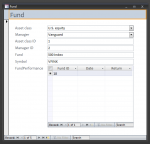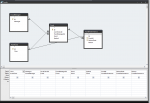Hello,
I am trying to make a form from a query [query.png], and I would like the form to be organized by the table, Fund, where Fund is a table on the “many” side of two one-to-many relationships [relationships.png]. That is, I would like the form to look similar* to the form in the attached screenshot [form.png], with the only subform being the one to do with Fund performance. Can this be done while keeping the data of related controls linked? I cannot figure-out how to get this to work:
When I enter a new record, and I enter the “Asset class” and “Manager” (fields), new records in their respective tables are created, which I don’t want. I don’t understand why this happens because, for both:
To rephrase, I have two main questions:
Ryan
PS
Wow, another question: Why does Access add a relationship line from AssetClass to FundPerformance in the query builder?
* I would actually like to delete the ID fields once everything is working; can I do this safely?
I am trying to make a form from a query [query.png], and I would like the form to be organized by the table, Fund, where Fund is a table on the “many” side of two one-to-many relationships [relationships.png]. That is, I would like the form to look similar* to the form in the attached screenshot [form.png], with the only subform being the one to do with Fund performance. Can this be done while keeping the data of related controls linked? I cannot figure-out how to get this to work:
When I enter a new record, and I enter the “Asset class” and “Manager” (fields), new records in their respective tables are created, which I don’t want. I don’t understand why this happens because, for both:
- Row source = a SELECT statement to select only what already exists (I have directly entered some records in the table)
- Limit To List = Yes
- Allow Value List Edits = No
To rephrase, I have two main questions:
- Why are new records being created in my form when, as far as I can see, am telling it not to?
- Can I make a single form that will take care of all the fields in my query—a form with two top-level superforms (for FundManager and AssetClass)?
Ryan
PS
Wow, another question: Why does Access add a relationship line from AssetClass to FundPerformance in the query builder?
* I would actually like to delete the ID fields once everything is working; can I do this safely?





